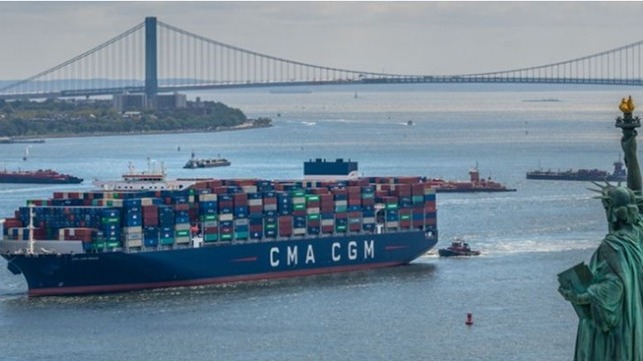Investment Plan to Improve NY Harbor, Deepen Channel and Anchorage

The Port Authority of New York and New Jersey announced a multifaceted package of significant investments in partnership with the U.S. Army Corps of Engineers to boost navigational safety and efficiency at the East Coast’s busiest container port. They plan to pursue a series of projects as part of the Port Authority's master plan which anticipates the seaport’s container volume will double or triple by 2050.
Port officials highlight that New York has already experienced significant growth as it looks to keep up with anticipated industry trends. Alphaliner, for example, projected this week that the newer ultra large containerships will be deployed on routes from Asia to the U.S. East Coast. So far, the industry has limited the deployment of the 23,000 to 24,000 TEU vessels to Northern Europe, but it is making vessels with 18,000 TEU capacity vessels available, and it is anticipated the industry will continue to build mega-ships to realize further economies of scale.
During the pandemic, the Port of New York and New Jersey handled cargo volumes that ranged from nearly 19 percent to more than 47 percent above the amount of cargo handled before the pandemic. In 2022, The Port Authority of New York and New Jersey was the country’s busiest port for four consecutive months during the industry’s shipping peak period. The Port of New York and New Jersey remains one of the country’s busiest ports rivaling the volumes handled at the Port of Los Angeles and Port of Long Beach on the West Coast.
During the presentation of the investment plan on Wednesday, May 29, the executives emphasized that the port supports over half a million regional jobs. Each year it contributes to the movement of more than $200 billion in goods.
The new investments between the Port Authority and the U.S. Army Corps of Engineers include more than $50 million through the Harbor Maintenance Trust Fund for the seaport’s berth maintenance dredging, berth rehabilitation, and berth reconstruction.
Additionally, a separate $32 million project will deepen and widen the Gravesend Anchorage outside the Kill van Kull waterway from its current depth of 47 feet to 50 feet, which will provide a location for large ships to anchor between Ambrose Anchorage in the Atlantic Ocean and the seaport’s container terminals. They stated that an anchorage space that is large and deep enough to handle the largest containerships calling the Port of New York and New Jersey will improve the port’s safety and efficiency, allowing large ships to move closer to the port during inspections, refueling, or inclement weather, and to have an emergency refuge area in the event of a mechanical or navigational issue.
The Port Authority’s longstanding partnership with the U.S. Army Corps of Engineers on the Channel Deepening Program dates to 1989, when both parties started work on a $2.1 billion project that deepened New York Harbor’s federal navigational channels to its current depth of 50 feet. Work on that initiative was completed in 2016, after which the Port Authority raised the roadway of the Bayonne Bridge to a navigational height clearance of 215 feet that allowed the largest container ships in the world at the time to sail through the Kill van Kull to access the port’s terminals in New York and New Jersey.
Anticipating the next phase of projects, they also signed an agreement to begin inspections of the current channel, ship simulation modeling and design, and the composition of plans and specifications for the eventual further deepen and widen the navigational channels in the port by an additional five feet. In December 2023, the Port Authority’s Board of Commissioners authorized participation in a $20 million project engineering and design effort, split evenly between the Port Authority and U.S. Army Corps, to further refine the cost and schedule for the New York/New Jersey Harbor Deepening and Channel Improvement Project.
Similar land side investments are also underway. This includes an ongoing $220 million project to redesign and rebuild the northern roadway entrance to Port Newark. Additionally, the Port Authority has invested more than $600 million to modernize its on-dock intermodal facilities that connect the port to the national freight rail network.
Earlier in the month, the Port Authority and the City of New York and the State also announced plans to overhaul parts of the waterfront. Under the swap agreement, the Port Authority will take full operational control of the city’s 225-acre portion of the Howland Hook Marine Terminal on Staten Island and coordinate its expansion with CMA CGM’s planned investment in the terminal. The City and State of New York take control of portions of the Brooklyn waterfront. The City will initially invest $80 million which will be used to stabilize and repair Piers 7, 8, and 10 and to fund the planning for the waterfront. Included in this is $15 million for new electric container cranes. New York aims to grow the existing specialized container business on the Brooklyn waterfront and incorporate it into a citywide micro-mobility strategy to reduce truck traffic.
